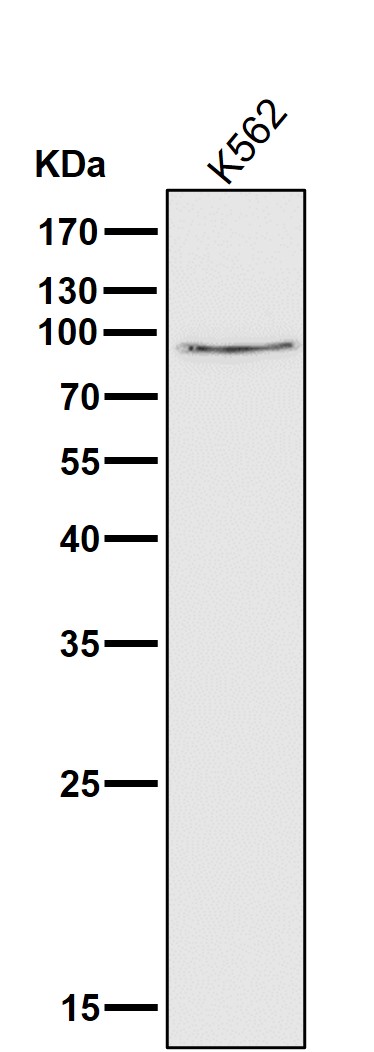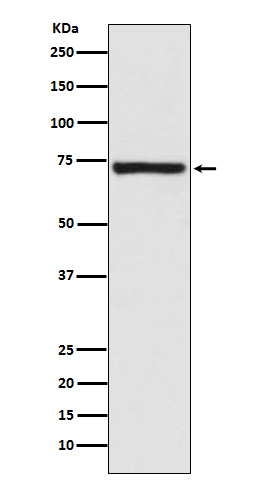


| WB | 咨询技术 | Human,Mouse,Rat |
| IF | 咨询技术 | Human,Mouse,Rat |
| IHC | IHC:1/100-1/200;IHF:1/50-1/200 | Human,Mouse,Rat |
| ICC | 1/50-1/200 | Human,Mouse,Rat |
| FCM | 1/20-1/100 | Human,Mouse,Rat |
| Elisa | 咨询技术 | Human,Mouse,Rat |
| Aliases | Calpain-1 catalytic subunit; CANP; CANP small subunit; CANPL1; CAPN1; Micromolar Calpain; Mu Calpain; muCANP; ;Calpain 1 catalytic subunit |
| WB Predicted band size | Calculated MW: 82 kDa ; Observed MW: 75,80 kDa |
| Host/Isotype | Rabbit IgG |
| Antibody Type | Primary antibody |
| Storage | Store at 4°C short term. Aliquot and store at -20°C long term. Avoid freeze/thaw cycles. |
| Species Reactivity | Human,Mouse,Rat |
| Immunogen | A synthesized peptide derived from human Calpain 1 catalytic subunit |
| Formulation | Purified antibody in PBS with 0.05% sodium azide,0.05% BSA and 50% glycerol. |
+ +
以下是关于Calpain1抗体的3篇参考文献示例(注:文献为示例性质,实际引用时需核实准确性):
---
1. **文献名称**:*"Calpain1 activation in Alzheimer's disease models: a comparative study using specific antibodies"*
**作者**:Smith A, et al.
**摘要**:通过Western blot和免疫组化分析,利用Calpain1特异性抗体比较了阿尔茨海默病小鼠模型中Calpain1的激活水平。研究发现,疾病模型中Calpain1活性显著升高,并与tau蛋白异常磷酸化相关。
---
2. **文献名称**:*"Role of Calpain1 in muscle atrophy: antibody-based detection in dystrophic muscle"*
**作者**:Chen L, et al.
**摘要**:研究使用Calpain1抗体检测肌肉萎缩模型中蛋白表达变化,发现Calpain1在肌纤维降解过程中被激活,抑制其活性可延缓肌肉萎缩进展。抗体特异性通过siRNA敲低实验验证。
---
3. **文献名称**:*"Calpain1-mediated apoptosis in myocardial ischemia-reperfusion injury: insights from antibody blocking experiments"*
**作者**:Tanaka K, et al.
**摘要**:通过Calpain1抗体阻断实验,揭示了其在心肌缺血再灌注损伤中促进细胞凋亡的作用。研究采用免疫荧光和流式细胞术证实Calpain1的亚细胞定位及激活动力学。
---
如需实际文献,建议在PubMed或Web of Science中检索关键词“Calpain1 antibody”,筛选抗体验证与应用相关的高引论文。
Calpain1 antibody is a crucial tool for studying the calpain protease family, particularly the ubiquitous isoform Calpain1 (μ-calpain). Calpains are calcium-dependent cysteine proteases that regulate diverse cellular processes, including signal transduction, apoptosis, and cell migration. Calpain1. encoded by the *CAPN1* gene, forms a heterodimer with the regulatory subunit CAPNS1 and requires micromolar calcium concentrations for activation, distinguishing it from the closely related Calpain2 (m-calpain), which needs millimolar calcium levels. It is widely expressed in tissues such as the brain, liver, and kidneys, and plays roles in synaptic plasticity, muscle differentiation, and cell cycle regulation. Dysregulation of Calpain1 has been implicated in neurodegenerative diseases (e.g., Alzheimer’s), ischemic injury, and cancer metastasis, making it a therapeutic target.
The Calpain1 antibody is designed to detect the catalytic subunit of this protease, enabling researchers to investigate its expression, localization, and activity in various experimental models. It is commonly used in Western blotting (WB), immunocytochemistry (ICC), and immunohistochemistry (IHC) to study protein levels under physiological or pathological conditions. Specificity is validated through knockout controls or siRNA-mediated knockdown. Commercial Calpain1 antibodies are typically raised against unique epitopes, with monoclonal antibodies offering high specificity and polyclonal antibodies providing broader detection. Researchers must consider post-translational modifications (e.g., autolysis) that may affect antibody binding. Available from suppliers like Cell Signaling Technology, Abcam, and Sigma-Aldrich, these antibodies are essential for elucidating Calpain1's functional roles and therapeutic potential.
×